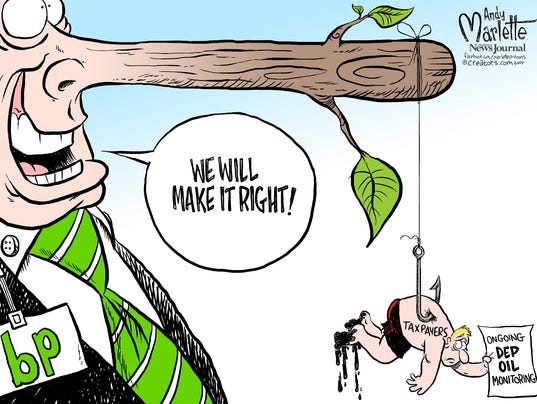The costs and energies of supervising the cleanup of a mess that we did not make should not rest entirely on our shoulders.
A promise was broken.
Maybe it’s all BP’s fault. Maybe the Coast Guard shares the blame. Maybe we’re all suckers for not getting it in writing. But we thought we had a deal.
The deal was that the Coast Guard-led and BP-funded oil spill cleanup would not leave our beaches until there was no more visible oil. But the Coast Guard declared the mission accomplished in 2013. And as we all know too well by now — the oil is still visible.
Pensacola News-Journal reporter Kim Blair spoke with Escambia County’s director of community and environment, Keith Wilkins, an official who has been on the front lines battling the oil spill since the day in 2010 when it began gushing wildly into the Gulf of Mexico. Wilkins summed up the broken promise like this: “At the very beginning of the oil spill, we were all talking about end points for monitoring and cleaning so we’d know when we were done with the whole thing … At the onset of the oil spill, we had an agreement with BP and the Coast Guard that the end point would be no observable oil on the beaches. We still have not reached that point.”
And that’s the bottom line. We have not reached the point of no visible oil. We still see tarballs. We still see tar mats. And under the gaze of a microscope, we can still see traces of the toxic dispersant chemicals that were futilely pumped into the Gulf.
For residents who take pride in leaving only footprints on our unique and beautiful shoreline, the disgusting stain of man-made folly is far from fading. And now, it’s clear that the heavy obligation to monitor the lingering results of BP’s mess has been shoved onto all of us.
BP initially paid Florida $50 million for oil monitoring and cleanup. Blair reported that the money dried up in June. The continued work is now financed by state taxpayers and it is unclear whether reimbursement will come from BP.
DEP workers Joey Whibbs and David Perkinson, the last two-man team left scouting for lingering oil from the 2010 spill, still find oil every day, five days a week. It was Perkinson who discovered the tar mat earlier this year on Fort Pickens beach. But even when they find it, time is of the essence. Rapidly changing surf and beach conditions require quick action before the oil is covered or washed elsewhere. And when the Coast Guard has not been immediately prepared to respond when alerted to discovery of oil, with the cleanup clock ticking, the exhausting work has fallen on the DEP’s two sentinels.
It is a Sisyphean task for just two men, the search for oil like a never ending push of a boulder down the beach. It should not be this way.
— Pensacola News Journal
